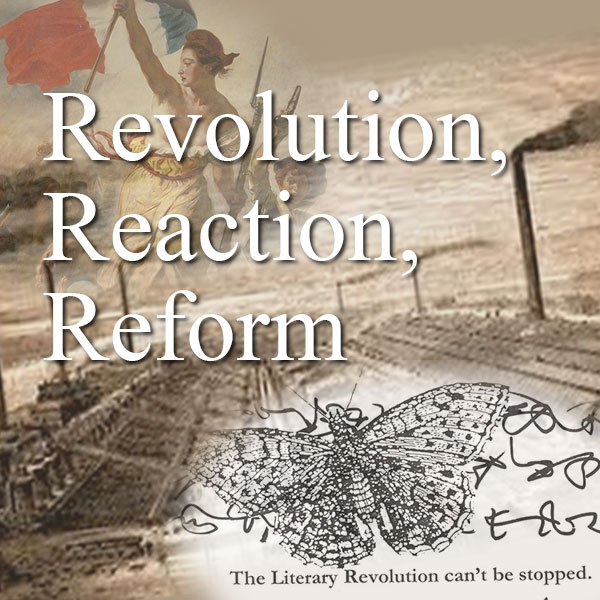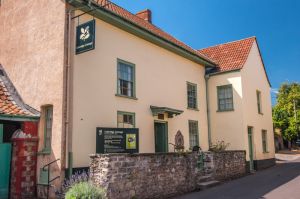This is the location of the St Mary's Church Conwy where Wordsworth was inspired to wrtie the poem "We are Seven"
MSSU ENG272 - Fall 2020 Dashboard
Description
 British Literature II: Revolution, Reaction, Reform examines British literature from the late eighteenth century to the present, a period that witnessed the American and French Revolutions, slave revolts such as the Haitian Revolution, a “revolution in female manners,” the Industrial Revolution, the twentieth-century revolutionary wave in Europe, as well as World War I and World War II, and, of course, artistic revolutions. We will consider how the authors and literary works of this period might be reacting to change, advocating for reform, or participating in literary revolutions—whether revolution is understood in the sense of “revolving” or of “revolting,” going full circle to return to a previous (more perfect?) time or experiencing/effecting a great alteration or rupture.
British Literature II: Revolution, Reaction, Reform examines British literature from the late eighteenth century to the present, a period that witnessed the American and French Revolutions, slave revolts such as the Haitian Revolution, a “revolution in female manners,” the Industrial Revolution, the twentieth-century revolutionary wave in Europe, as well as World War I and World War II, and, of course, artistic revolutions. We will consider how the authors and literary works of this period might be reacting to change, advocating for reform, or participating in literary revolutions—whether revolution is understood in the sense of “revolving” or of “revolting,” going full circle to return to a previous (more perfect?) time or experiencing/effecting a great alteration or rupture.
We'll be using the following texts at COVE Studio in the anthology British Literature II (MSSU), Fall 2020:
Wordsworth, William, "We Are Seven" (1798)
Coleridge, Samuel Taylor, "Eolian Harp" (1795)
Coleridge, Samuel Taylor, "Metrical Feet: Lesson for a Boy"
Shelley, Mary, Frankenstein; or, The Modern Prometheus (1818)
Browning, Robert, "Porphyria's Lover" (1836)
Browning, Robert, "My Last Duchess" (1842)
Browning, Robert, "Soliloquy of the Spanish Cloister” (1842)
Tennyson, Alfred, "The Lady of Shalot" (1832 and 1842)
Browning, Elizabeth Barrett, "The Cry of the Children" (1843)
Hood, Thomas, "The Song of the Shirt" (1843)
Brooke, Rupert, "The Soldier" (1914)
Eliot, T. S., "The Love Song of J. Alfred Prufrock" (1915, 1917)
Woolf, Virginia, "The Mark on the Wall" (1921)
Auden, W.H., "Musée des Beaux Arts" (1939, 1940)
Thomas, Dylan, "Do Not Go Gentle into That Good Night" (1951)
Galleries, Timelines, and Maps
There is no content in this group.
Individual Entries
The Bastille was a French Prison that was raided on July 14th, 1789 and sparked the French Revolution. The prison was located in Paris and was a symbol of the harsh rule of the monarchy. At the time of the attack, the prison only housed seven prisoners. Yet the prisoners were unharmed because the angry mob only come for the ammunition that was stored there. The governor of the prison tried to stop the mob but was unsuccessful. The mob killed and decapitated the governor and took control of the prison. This was the beginning of the French Revolution and the end of the monarchy.
Learning Timelines: Sources from History. British Library.
The Old Jewry is where Richard Price gave his famous sermon A Discourse on the Love of Our Country. In this sermon Price commemorated the Glorious Revolution and gave his support for the French Revolution (Libertyfund.org). The Glorious Revolution involved the overthrw of the Catholic king James II, who was replaced by his Protestant daughter Mary and her husban, William of Orange (History.com).
Bibliography
FRANCE., T. (n.d.). Online Library of Liberty. Retrieved September 08, 2020, from https://oll.libertyfund.org/titles/price-a-discourse-on-the-love-of-our-...
History.com Editors. (2018, February 20). Glorious Revolution. Retrieved September 08, 2020, from https://www.history.com/topics/british-history/glorious-revolution

Samuel Taylor Coleridge lived in this cottage with his family for three years. It is located in Nether Stowey, England and is surrounded by a beautiful landscape, which he contributed into some of his writings. This is where Coleridge got his inspiration and where his poetry soon came to life. This marks an important event in Samuel's life because this gave him more opportunity to expand on his poetry and to do what he loved.
Bibliography
Ross, David. "Coleridge Cottage". Britain Express. 7 September 2020, https://www.britainexpress.com/attractions.htm?attraction=2044
"Coleridge Cottage". National Trust. 7 September 2020, ...
more